The Sauterne and Origami Arabica Crop – Brazil’s Drought Situation in Coffee
April 8th, 2014.
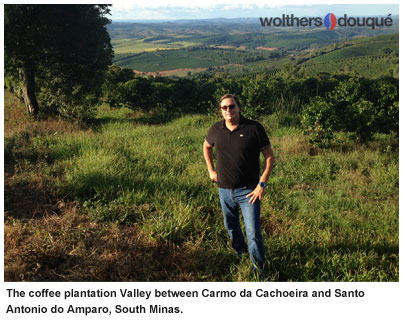 I have just returned from my tour through the Strictly Soft, Fine Cup and Specialty grade regions of Brazil.
I have just returned from my tour through the Strictly Soft, Fine Cup and Specialty grade regions of Brazil.
The South of Minas Gerais holds the record of highest density of coffee tree population in the world, also the first producer in volume of fine Arabica beans in Brazil/world.
The plantations between Varginha and Santo Antonio do Amparo, including Oliveira, Carmo da Cachoeira, Boa Esperanca, Tres Pontas and through Guaxupe are the record holding in density and quality Regions/Districts.
These are exactly the Districts that suffered the highest negative impact of the drought, excess heat waves and low air humidity that started late November 2013 and lasted through the end of February 2014.

I am calling this crop the ” Sauterne and Origami Arabica crop ” due to the over – ripe, very sweet and soft cherries added by the tangled defective malformed beans inside.
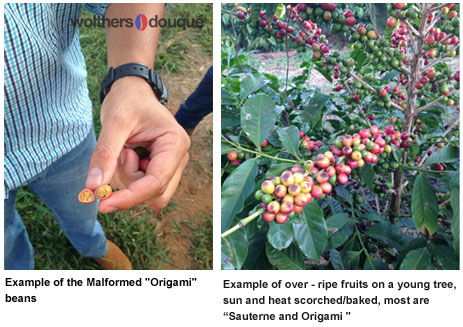 While the plantations look healthy and with relative good quantity of fruits, once one examines closely, the reality is of a high amount of watery, single, small and defective formation, dead and discolored beans inside.
While the plantations look healthy and with relative good quantity of fruits, once one examines closely, the reality is of a high amount of watery, single, small and defective formation, dead and discolored beans inside.
I picked good quantity of fruits and could feel their raisin and excessively soft texture, easy to squeeze manually and as I cut these cherries and green fruit, I found many disorganized defective beans inside, thus the “Origami “expression.
This was the first time I saw these badly formed beans, they look like twisted and layered paper bundle, these beans will result in negative revenue to the producer, worthless to harvest.
Many producers will wait to harvest in the hope that further rains help the smaller green and still unripe fruits develop, a long shot at this point as the regular dry season has already started.
Branch growth where the next harvest ( 2015/16 ) should be secured through the formation of average 13 internodes, have a maximum of 6 to 9 formed nodules, this will affect next crop negatively.
It remains quite hot as the average mid-day temperatures last week remained at 38 degrees Celsius/100 Fahrenheit; this does not help further bean development.
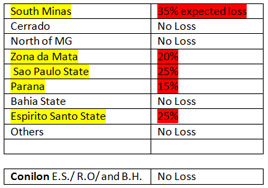 Arabica crop:
Arabica crop:
“In Yellow, the hardest impact due to drought, record high temps and record low air humidity + revised potential loss percentage”
Carry-Over
“This is the main and crucial point to tighten or relax the nearby supply issue under the current circumstances”.
Our figures show the following scenario:
Brazil’s average exports – 33 million bags/year
Brazil’s internal Consumption – 20 Million/year
January 1rst/2014 Carry Over: 37.5 Million bags
Disappearance Jan 1rst/14 – March 30th/14: 13 Million bags
Expected disappearance April/14 – June 30th/14: 14.5 Million bags
Expected Carry Over on July 1rst 2014: 10 million bags
Other Considerations
Strictly Soft/Fine Cup and Specialty grade normally represent about 50% of the Arabica harvest; this percentage can be reduced due to Beetle Boar and Bicho Mineiro attacks.
Normally, screen 17/18 beans represent about 33% of the Arabica crop, this year that percentage can be reduced by about 60% due to low bean growth.
Quality may be further deteriorated in case it rains under the harvest season.
The Furnas Lake is in its lowest level since its formation almost 50 years ago, the plantations around it ” hundreds of thousands of hectares ” are mostly under 850 meters altitude, these are now unprotected against frost.
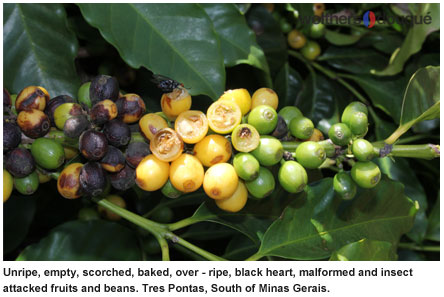
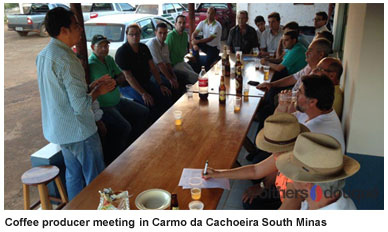
Next Crop, 2015/2016
Only a few comments which are based on the amount of pruned trees, non-growing young plantations, reduced branch growth and the normal low productivity cycle of the plantations.
Farmers now expect a reduction due to lesser branch growth and lesser internodes, only in the drought struck areas.
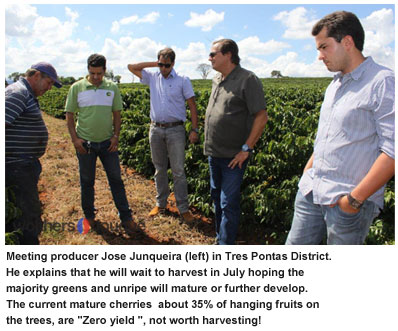
Food for thought
If export figures and internal consumption remain close to the last three years average of 33 Mio and 20 Mio bags, Brazil might become short of supply if next 2015/16 crop is substantially smaller
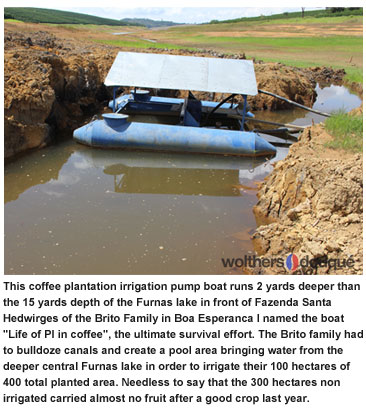 Pulped Natural and Full Washed coffees for this coming crop will be very restricted as the maturation is mostly messed up, this promotes Natural preparation.
Pulped Natural and Full Washed coffees for this coming crop will be very restricted as the maturation is mostly messed up, this promotes Natural preparation.
There are many predictions in the market for the 2014 crop these range from 43 million to 54 million bags, both sides seem exaggerated but the reality will first be known by the producers themselves as it is impossible to predict while looking at fruit only, not dry milled coffee beans.
I would rather concentrate on this 2014 crop quality and next crops ( 2016 ) quantity.





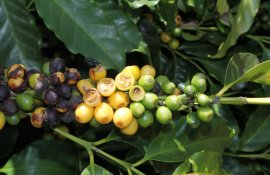


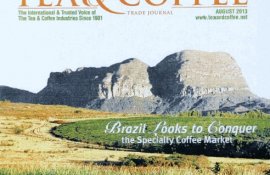
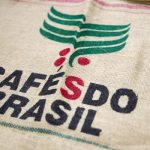
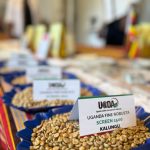

Great article, thank you! What are your thoughts on the 2014 crop following some of the April/May rains? Did these have any positive impace on the 2014 harvest or was it just too late…